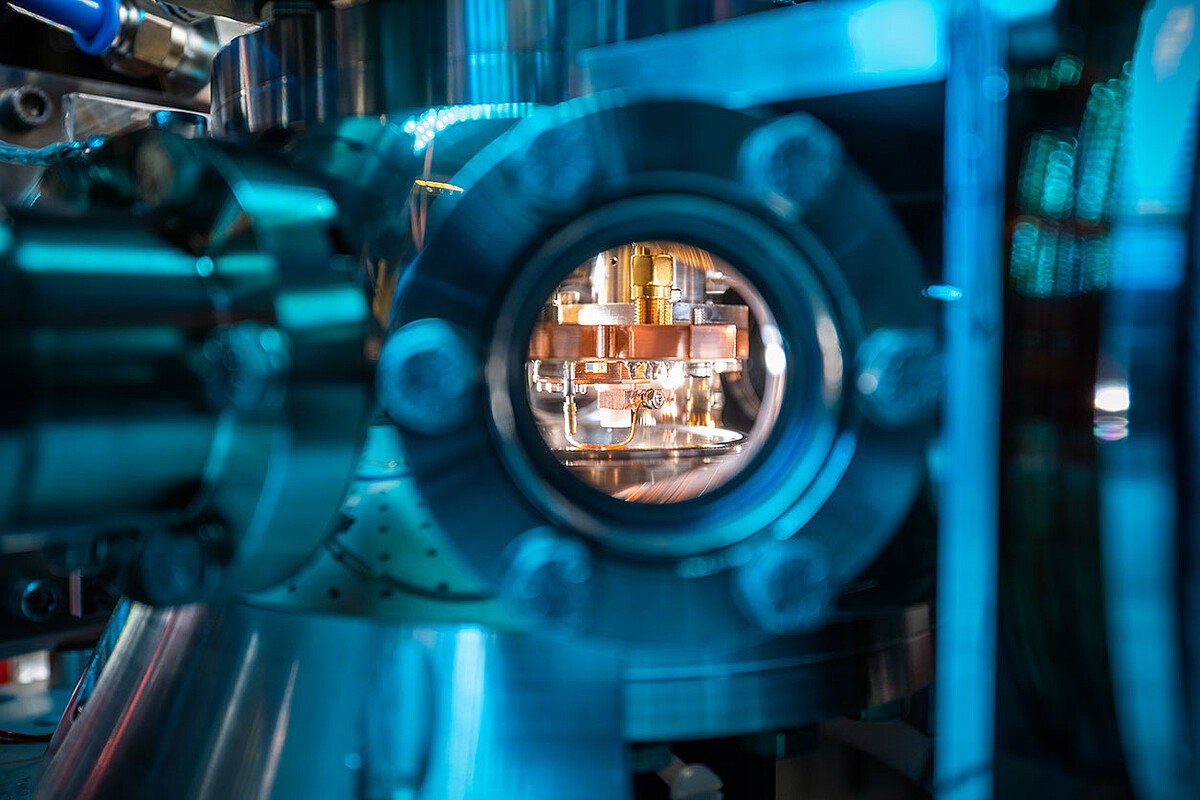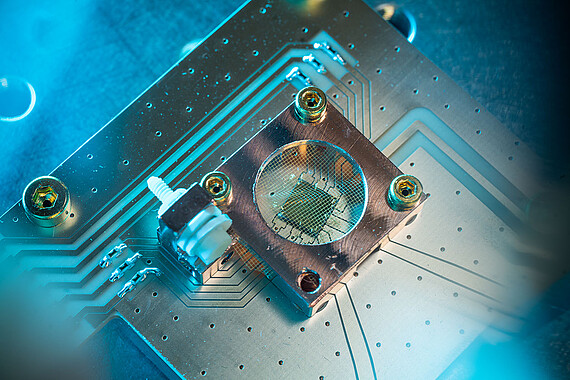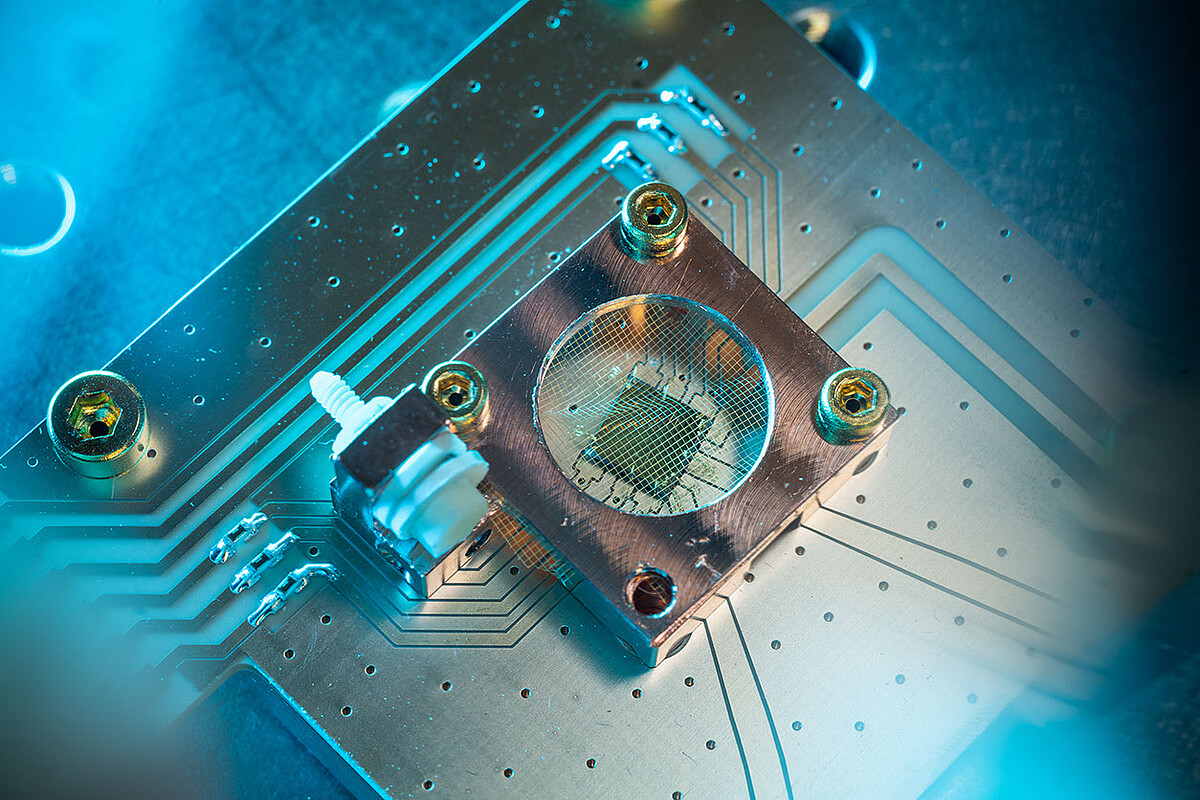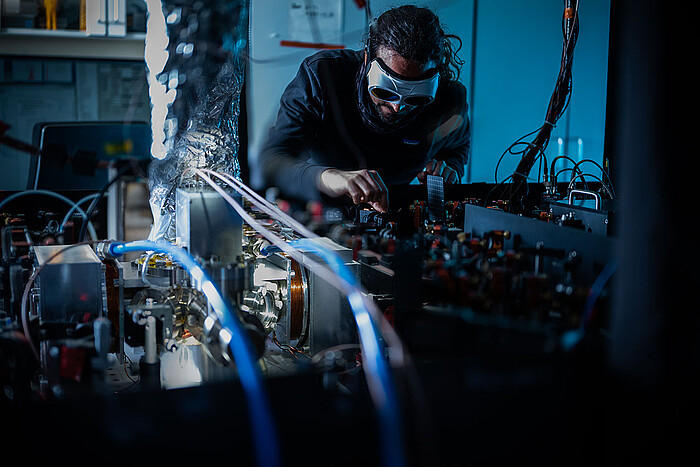"T-shhhhhhhh, T-shhhhhhhh" That's what it sounds like when you want to calculate with qubits. As with normal computers, the loudest part of the quantum computer demonstrator at the Institute of Quantum Optics is the cooling. Only here, the processor is not cooled with a miniature windmill, but is frozen to cryogenic temperatures with helium at five degrees Kelvin. The rhythmic "T-shhhhhh" is accompanied by the humming of numerous electronics. It's a whole laboratory full of technology. And every part contributes to the marvel. On the right is a screen on which the scientists are currently viewing the all-important chip. In the centre is a room-dominating laboratory table with optical instruments – lenses, beam splitters and lasers that send customised light towards the ion trap. And there is the centrepiece: encased in a vacuum chamber and headed, so to speak, by the cooling pump, a trap awaits its ions. There, on just a few square micrometres, is what scientists at Quantum Valley Lower Saxony are working on: Computing with ions.
Why ions?
Ideas for quantum computers now exist in a wide variety of architectures. In addition to ion traps, you can read about superconducting qubits, spin qubits or nitrogen-vacancy centres in diamond lattices (NV centres). In the search for the best quantum computer, each of these architectures has different strengths and weaknesses due to their physical properties.


 ©
Jan Hosan
©
Jan Hosan
For example, superconducting computers can already boast many qubits, but these are only stable for fractions of a second. The qubits in NV centres, on the other hand, are literally as hard as diamonds, but so far hardly more than four centres come close enough together for a computer.
In comparison, the trapped ions also remain stable over long periods of time and get along much better in a dense space than the NV centres – but here too there is currently still a limit to how many ions can be brought together. In short, it is currently impossible to predict which architecture(s) will prevail in the long term and for which purposes which approach is best suited. Accordingly, one of the key buzzwords is scalability. Which architecture will be able to bring together not just 50 or 500 qubits in the future, but a whole million?
Taking a broad path to success
It's just a short walk through the Welfengarten to Hannover's nearest quantum computer laboratory. At HITec, the new computers are being built in two rooms. However, it is still very quiet here. No hissing cooling, just lab benches filling up. In contrast to the first prototype from earlier, everything here is designed for computing with ions right from the start. The chip is designed to accommodate significantly more qubits. For the researchers, this means realising a concept that has mainly worked in theory so far.


 ©
Jan Hosan
©
Jan Hosan
Professor Christian Ospelkaus: "Of course, we have a detailed plan and several demonstrators at the same time. So if we encounter a problem with one demonstrator, another may be able to help us with the solution. As we are generally venturing into uncharted territory with the setups, we also have to factor in free space for the unforeseeable. For example, part of the chip area is needed for small microwave components, which are used to perform the calculations on the ions.
A matter of temperature
There is another demonstrator in Quantum Valley Lower Saxony. However, this one is located at the Physikalisch-Technische Bundesanstalt in Braunschweig. The most obvious difference to the Hanover set-ups: There is no helium cooling at the PTB. So why the additional effort at the Hanover site? Both approaches cool the individual ions by slowing down their kinetic energy with laser beams. Ion traps at room temperature are therefore perfectly feasible for the scientists. But up to how many ions it makes sense to play the game still needs to be researched. At room temperature, for example, there is a risk of residual gas particles colliding with the ions in a vacuum and ejecting them from their trap. If, on the other hand, you try to compensate for this weak point with more voltage, you have a good chance of destroying the chip.
Instead, the researchers reduce the background noise and improve the vacuum by cooling the entire chip down to around 4 degrees Kelvin. What sounds like an extreme temperature is comparatively easy to handle from a physicist's perspective. Compared to superconducting qubits in computers from IBM and the like, the temperature required to achieve the desired properties is nowhere near as low.
In addition, the concept of the quantum computer must not only function, it must also be scalable. Temperature plays an important role here. "There are other approaches to making ion traps stable at room temperature with high voltage, but the chips then become macroscopically large and lose their potential to be scaled up. Although we are also faced with the challenge of scalability, we also have several ideas on how we can make progress there. Accordingly, we are developing the technologies that will allow us to scale up our demonstrators for more qubits step by step," says Professor Christian Ospelkaus.


 ©
Jan Hosan
©
Jan Hosan









